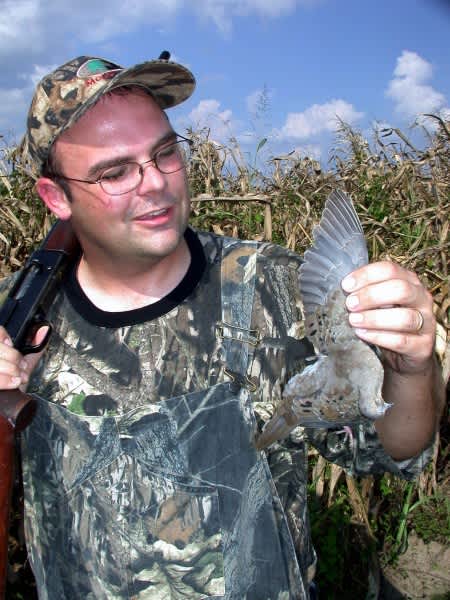Hydration, Chokes, and Decoys for Dove Hunters with Marty Fischer
John E. Phillips 09.26.13

Author’s note: Marty Fischer, the host of TNT Outdoor Explosion on the Pursuit Channel, a professional wingshooter, a National Sporting Clays Association Level III shooting instructor, and a longtime Mossy Oak Pro Staff member, has designed more than 150 sporting clay facilities. Here are his tips for taking more doves.
Stay hydrated
Many hunters overlook the fact that if you are not sufficiently hydrated, you won’t shoot as accurately as you can. Also, if you are taking a retrieving dog with you to the dove field, it’s important to take water for the dog. Early season dove hunting, especially in the South, usually occurs when the region has really hot days. Water is the easiest hydration solution but sports drinks can also be beneficial to the dove hunter.
There is another product that I use a lot that has really helped me over the years. It is called PowerGel, made by PowerBar. I was introduced to this product by a fishing guide who also hunts pheasant out in Nebraska. The weather was really cold, and we were probably about a half-mile from our truck. After a hard day of hunting, my blood sugar went off a cliff. I normally don’t have any problem with my blood sugar, but on this day I did. All I had was some water to drink. My guide suggested, “Here take this. Squirt this down your throat and then take a big drink of water and you will be okay.” Within five minutes of taking the PowerGel and washing it down with water, I felt like I could run a marathon. There are all types of products like this on the market that long-distance runners use quite a bit.
Proper choke size
In the early season, you will be harvesting many young doves. Their feathers are not nearly as thick, nor are the doves as big as the birds you will take later in the season. So I advise using a choke with a fairly open pattern. You are not trying to disintegrate the dove, you are just putting enough pellets to quickly, cleanly, and efficiently bring it down. During the early season, I use either an improved cylinder choke or barrel, or a light modified choke. These two chokes are very efficient from 20 to about 32 yards away. During the early season, most of the shots that dove hunters take will be within that range. If the dove comes closer than 20 yards, the choke you use won’t matter much because the pattern is still going to be tight. Chokes start to perform at distances from about 20 to 35 yards.
Later in the season, I move up one choke tighter and sometimes use a modified choke since the doves are bigger and stronger. The wind also tends to blow more later in the season, so the doves tend to be spookier, and generally food sources are father apart. The doves in late winter are usually much more difficult to take than they are earlier in the season. That’s why I use a tighter choke. I assume my shots later in the season will be farther away from me than they had been earlier.
Proper shot size
During the early season, I shoot No. 8 shot. Later in the season, I shoot No. 7-1/2-shot. I don’t really think you need to increase your shot size to No. 6 in the late season because usually No. 7-1/2-shot will down a dove out to 45 yards. If you are taking shots from more than 45 yards, you are just guessing as to whether you can down them or not.
One good exercise is to step off the yardage from your stand site out to 45 yards. When you see how far 45 yards actually is, you’ll better understand how hard it is to see a dove in flight at that distance. Oftentimes, you will hear dove hunters brag “I downed that bird at 60 or 70 yards.” But rarely will those same hunters step off the yardage to know exactly how far the dove was from them.
The importance of decoys
I think dove decoys are great. I think a spinning-wing decoy, like the type that MOJO makes, is even better because doves are attracted to the motion. When doves are flying into a field, they are looking down to decide where they want to go. If they see movement that is uncommon or unnatural (like a hunter moving), they will be alerted and often veer away from that movement. However, if they see movement that is natural, like a spinning-wing dove decoy, they will come closer to get a better look. I have found that dove decoys can be very effective, and spinning-wing dove decoys tend to be the most effective for drawing in doves.
Mossy Oak and ScoutLook Weather have teamed-up to give away a GilesIsland deer hunt and gear package worth almost $5,000. Go to http://www.mossyoak.com/weather-app-contest?id=OH-1 to learn more.

